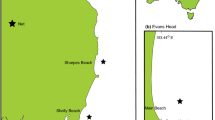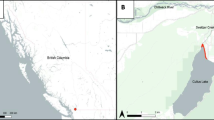Abstract
In fall of 2009, several mass strandings of Humboldt squid (Dosidicus gigas) occurred on Vancouver Island (49°7′60N 125°54′0W). Morphological dissections coupled with DNA barcoding of stomach contents revealed Sardinops sagax (Pacific sardine) and Clupea pallasii (Pacific herring) as their primary prey. Plastic nurdles, fishing line, bull kelp, eelgrass, and a guillemot feather were also discovered. The primary prey, Pacific sardines and Pacific herring, are known to bioaccumulate paralytic shellfish toxins (PSTs); additionally, both PSTs and domoic acid (DA) have been implicated in other mass strandings. Therefore, stomach contents, and other tissues when possible, were tested for PSTs and DA. Testing revealed DA concentrations below regulatory guidance levels for human consumption, yet PSTs were well in excess. Though we cannot conclude that PSTs were the definitive cause of the strandings, our findings are the first report of PSTs in D. gigas.


Similar content being viewed by others
References
Anderson PAV, Roberts-Misterly J, Greenberg RM (2005) The evolution of voltage-gated sodium channels: were algal toxins involved? Harmful Algae 4:95–107
AOAC (2005) Paralytic shellfish poisoning toxins in shellfish: prechromatographic oxidation and liquid chromatography with fluorescence detection. Official method 2005.06, A. M. In: Official methods of analysis
AOAC (2007) Domoic acid toxins in shellfish: biosense ASP ELISA—a competitive direct enzyme-linked immunosorbent assay. Official method 2006.02, A. M. In: Official methods of analysis
Bargu S, Powell CL, Wang Z, Doucette GJ, Silver MW (2008) Note on the occurrence of Pseudo-nitzschia australis and domoic acid in squid from Monterey Bay, CA (USA). Harmful Algae 7:45–51
Bolstad KS, O’Shea S (2003) Gut contents of a giant squid Architeuthis dux (Cephalopoda: Oegopsida) from New Zealand waters. N Z J Zool 31:15–21
Cosgrove JA (2005) The first specimens of Humboldt squid in British Columbia. PICES Press 13(2):30–31
Costa PR, Botelho MJ, Rodrigues SM (2009) Accumulation of paralytic shellfish toxins in digestive gland of Octopus vulgaris during bloom events including the dinoflagellate Gymnodinium catenatum. Mar Pollut Bull 28:1747–1750
Deeds JR, White KD, Etheridge SM, Landsberg JH (2008) Concentrations of saxitoxin and tetrodotoxin in three species of puffers from the Indian River Lagoon, Florida, the location for multiple cases of saxitoxin puffer poisoning from 2002–2004. Trans Am Fish Soc 137:1317–1326
DFO (2010) State of the Pacific Ocean 2009. DFO Can Sci Advis Sec Sci Advis Rep 2010/034
Ehrhardt NM (1991) Potential impact of seasonal migratory jumbo squid (Dosidicus gigas) stock on a gulf of California sardine (Sardinops sagax caerulae) population. Bull Mar Sci 49:325–332
Etheridge SM, Deeds J, Hall S, White K, Flewelling L, Abbott J, Landsberg J, Conrad S, Bodager D, Jackow G (2006) Detection methods and their limitations: PSP toxins in the southern puffer fish Sphoeroides nephelus responsible for human poisoning events in Florida in 2004. Afr J Mar Sci 28:383–387
Field JC, Walker WA, Phillips AJ (2007) Range expansion and trophic interactions of the jumbo squid, Dosidicus gigas, in the California Current. Cal Coop Ocean Fish Investig Rep 48:131–146
Folmer O, Black M, Hoeh W, Lutz R, Vrijenhoek R (1994) DNA primers for amplification of mitochondrial cytochrome c oxidase subunit I from diverse metazoan invertebrates. Mol Mar Biol Biotechnol 3:294–299
Gilly WF (2005) Spreading and stranding of jumbo squid. Ecosystems observations for the Monterey Bay national marine sanctuary 2005:25–26. http://montereybay.noaa.gov/reports/2005/eco/ecoobs2005.pdf. Viewed 1 Mar 2010
Gulland FMD, Haulena M, Fauquier D, Langlois G, Lander ME, Zabka T, Duerr R, Langlois G (2002) Domoic acid toxicity in California sea lions (Zalophus californianus): clinical signs, treatment and survival. Vet Rec 150:475–480
Hebert PDN, Cywinska A, Ball SL, deWaard JR (2003) Biological identifications through DNA barcodes. Proc R Soc B 270:313–321
Hebert PDN, Penton EH, Burns JM, Janzen DH, Hallwachs W (2004a) Ten species in one: DNA barcoding reveals cryptic species in the Neotropical skipper butterfly Astraptes fulgerator. Proc Natl Acad Sci USA 101:14812–14817
Hebert PDN, Stoeckle MY, Zemlak TS, Francis CM (2004b) Identification of birds through DNA barcodes. PLoS Biol 2(10):1657–1663
Ibáñez CM, Keyl F (2010) Cannibalism in cephalopods. Rev Fish Biol Fish 20:123–136
Ibáñez CM, Arancibia H, Cubillos LA (2008) Biases in determining the diet of jumbo squid Dosidicus gigas (D’ Orbigny 1835) (Cephalopoda: Ommastrephidae) off southern-central Chile (34°S–40°S). Mar Res 62:331–338
Ivanova NV, deWaard JR, Hebert PDN (2006) An inexpensive, automation-friendly protocol for recovering high-quality DNA. Mol Ecol Notes 6:998–1002
Ivanova NV, Zemlak TS, Hanner RH, Hebert PDN (2007) Universal primer cocktails for fish DNA barcoding. Mol Ecol Notes 7:544–548
Jester RJ, Baugh KA, Lefebvre KA (2009) Presence of Alexandrium catenella and paralytic shellfish toxins in finfish, shellfish and rock crabs in Monterey Bay, California, USA. Mar Biol 156:493–504
Landsberg JH (2002) The effects of harmful algal blooms on aquatic organisms. Rev Fish Sci 10(2):113–390
Lefebvre KA, Dovel SL, Silver MW (2001) Tissue distribution and neurotoxic effects of domoic acid in a prominent vector species, the northern anchovy Engraulis mordax. Mar Biol 138:693–700
Lefebvre KA, Elder NE, Hershberger PK, Trainer VL, Stehr CM, Scholz NL (2005) Dissolved saxitoxin causes transient inhibition of sensorimotor function in larval Pacific herring (Clupea harengus pallasi). Mar Biol 147:1393–1402
Llewellyn L, Negri A, Robertson A (2006) Paralytic shellfish toxins in the tropical oceans. Toxin Rev 25:159–196
Markaida U, Sosa-Nishizaki O (2003) Food and feeding habits of jumbo squid Dosidicus gigas (Cephalopoda: Ommastrephihdae) from the Gulf of California, Mexico. J Mar Bio Association UK 83:507–522
Markaida U, Gilly WF, Salinas-Zavala CA, Rosas-Luis R, Booth JTA (2008) Food and feeding of jumbo squid Dosidicus gigas in the Central Gulf of California during 2005–2007. Cal Coop Ocean Fish Investig Rep 49:90–103
Mato Y, Isobe T, Takada H, Kanehiro H, Ohtake C, Kaminuma T (2001) Plastic resin pellets as a transport medium for toxic chemicals in the marine environment. Environ Sci Technol 35:318–324
Nigmatullin CM, Nesis KN, Arkhipkin AI (2001) A review of the biology of the jumbo squid Dosidicus gigas (Cephalopoda: Ommastrephidae). Fish Res 54:9–19
Ratnasingham S, Hebert PDN (2007) BOLD: the Barcode of Life Data System (http://www.barcodinglife.org). Mol Ecol Notes 7:355–364
Robertson A, Stirling D, Robillot C, Llewellyn L, Negri A (2004) First report of saxitoxin in octopi. Toxicon 44:765–771
United States Food Drug Administration (2001) Fish and fisheries products hazards and controls guidance: third edition. Department of Health and Human Services, Center for Food Safety and Applied Nutrition, Washington DC
Wilson JJ (2010) Barcodes help solve riddle of the stranded squid. BARCODE bull 1(4):10. http://ibol.org/news-and-events/newsletter/ Accessed 5 May 2011
Wong EHK, Hanner RH (2008) DNA barcoding detects market substitution in North American seafood. Food Res Int 41(8):828–837
Work TM, Barr B, Beale AM, Fritz L, Quilliam MA, Wright JLC (1993) Epidemiology of domoic acid poisoning in brown pelicans (Pelicanus occidentalis) and Brandt’s cormorants (Phalacrocorax penicillatus) in California. J Zoo Wildl Med 24:54–62
Zeidberg LD, Robison BH (2007) Invasive range expansion by the Humboldt squid, Dosidicus gigas, in the eastern North Pacific. Proc Natl Acad Sci USA 104:12948–12950
Acknowledgments
We would like to thank the following people for their insights and comments on an earlier draft of this manuscript: Timothy Bartley, Amanda Naaum, Elizabeth Clare, Robin Floyd, and Kevin Kerr. Andy Braid, Joan Rafter, and the people at VIA Rail assisted in transporting the specimens. We would also like to thank the kind people at Takis’ Taverna for storing our specimens in their freezer while logistical transportation issues were being resolved. We acknowledge the University of Guelph URA and Work Study programs for support of HB, as well as funding from the Canadian Barcode of Life Network via Genome Canada (through the Ontario Genomics Institute), the Natural Sciences and Engineering Research Council (NSERC), and the Ontario Ministry of Research and Innovation, for sequencing and informatics support as provided by the Biodiversity Institute of Ontario.
Author information
Authors and Affiliations
Corresponding author
Additional information
Communicated by D. Righton.
Electronic supplementary material
Below is the link to the electronic supplementary material.
Rights and permissions
About this article
Cite this article
Braid, H.E., Deeds, J., DeGrasse, S.L. et al. Preying on commercial fisheries and accumulating paralytic shellfish toxins: a dietary analysis of invasive Dosidicus gigas (Cephalopoda Ommastrephidae) stranded in Pacific Canada. Mar Biol 159, 25–31 (2012). https://doi.org/10.1007/s00227-011-1786-4
Received:
Accepted:
Published:
Issue Date:
DOI: https://doi.org/10.1007/s00227-011-1786-4




